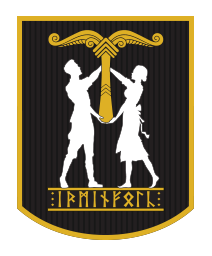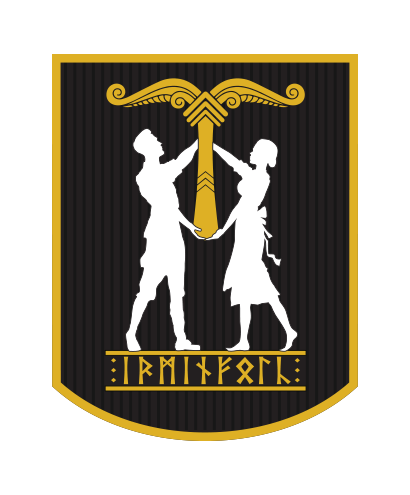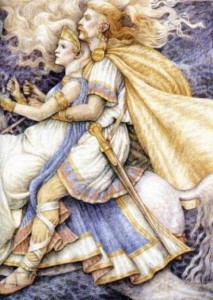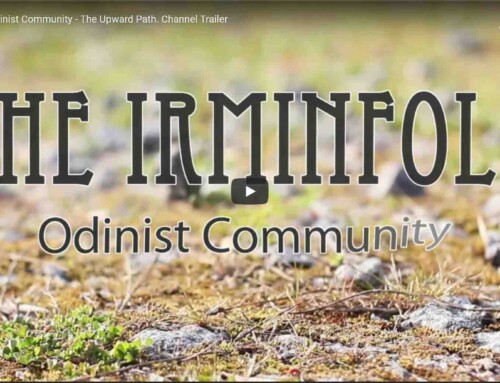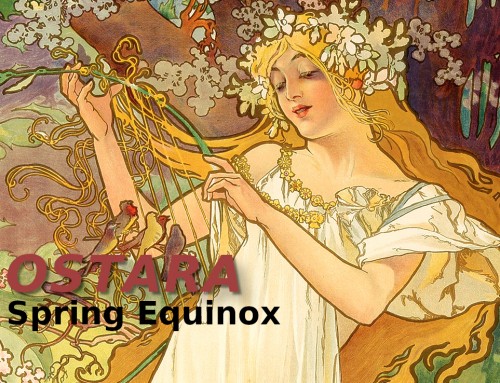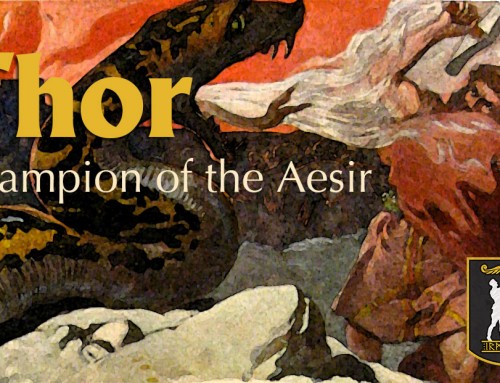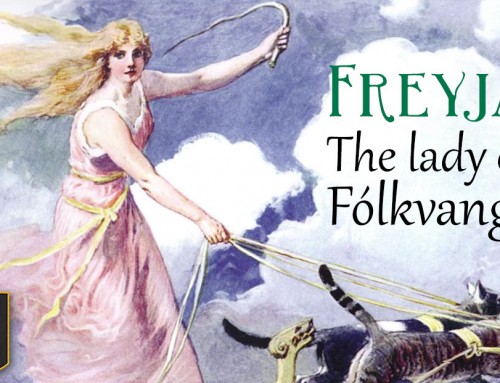St. Patrick is said to have lived in the 5th Century, although only two contemporary documents attest to his existence: the Letter to Coroticus and a last confession. Both documents are written in the first person. Accepting St. Patrick’s historical existence on this evidence is an act of faith.
The popular tales of St. Patrick’s life — that he chased snakes (read- pagans) out of Ireland and used the shamrock to explain the Holy Trinity — were developed between the 8th and 14th centuries: hundreds of years after the time when St. Patrick is said to have lived. In the majority of these tales, Patrick is a Christian religious-culture “hero” who rescues the Irish from the influence of the wily Druids (the “snakes”) and their pagan beliefs. However, some St. Patrick tales are told from the pagan perspective. These tales match Patrick against Oisin, a semi-divine Celtic warrior/poet who embodies the pagan Celtic culture and its resistance to Christianity. In these unfortunately less popular tales, Patrick appears as a dogmatic, fire and brimstone spouting bigot: “Patrick of the closed mind”, as Oisin calls him.
Taken together, the St. Patrick and Oisin tales constitute a dialogue that is also a theological battle between Christianity and Celtic paganism. These tales may have emerged from oral tradition and been written down later or they may have sprung from the pens of Christian monks and Druidic scribes and been circulated among the people as propaganda. Whether or not Oisin and Patrick ever existed, within these tales the characters “Oisin” and “Patrick” personify paganism and Christianity, and their “arguments” represent the historical duel of these theologies in medieval Irish culture.
The fact that these oppositional tales were still in lively circulation in Ireland in the 1400’s suggests that the conflict between paganism and Christianity may have persisted long after the period when Patrick supposedly Christianized the Irish. Certainly the idea that one man converted all the pagan tribes of Ireland to Christianity in a single lifetime is the detail of the St. Patrick story that is the most difficult to accept literally. The ancient Celts worshiped courage, generosity and beauty, and had no concept of the Christian virtues of mercy, non-violence and humility. Early Irish poetry is full of celebrations of battle, bloodshed and violence. One man confronting these ferocious warriors with the idea that their belief system was in need of a thorough rethink would have been lucky to keep his head on his shoulders.
It seems more likely that in Ireland, as in the rest of Europe, the conversion of the population from paganism to Christianity took place slowly. “St. Patrick” is thus, perhaps, the heroic personification of a conversion process that was carried forward anonymously by many missionaries and monks over centuries. By the 8th century, most of Ireland had been Christianized and this is also the period when the dialogues known as “Oisin’s Arguments with St. Patrick” began to achieve popularity. This is the story of how Oisin met Patrick:
Oisin (oh-sheen) was the last of the Fianna, a warrior tribe who lived in Ireland in the 2nd and 3rd centuries. Fionn mac Cumhail (fin-mac-cool), Oisin’s father, was the leader of the Fianna. Oisin was hunting in the forest one day when he came upon a young woman with the head of a pig. Oisin asked her what had happened and she told him a Druid had put the pig’s head on her when she refused his advances. The only way to break the spell was to find a man who would marry her. Generosity was the code of the Fianna, so Oisin asked for her hand. As soon as the vows were spoken, the pig’s head vanished and the young woman was restored to her natural beauty. She now revealed her true identity to Oisin: she was Niamh, daughter of the king of Tir na Nog (Teer-na-Nogue — Land of the Young).
When Fionn heard that Niamh had invited Oisin to accompany her to Tir na Nog, he warned Oisin that if he went with Niamh he would never see Fionn and the Fianna alive again. Oisin tried to reassure his father that he would not be gone for long, but Fionn would not be comforted. Nevertheless, Oisin and Niamh traveled across the ocean to Tir na Nog on Niamh’s magical white horse. In Tir na Nog, Niamh’s father made Oisin as welcome as if Oisin had been his own son. Time did not exist in Tir na Nog. Youth and beauty never faded; fruit was always on the trees; the rivers and lakes overflowed with salmon and trout; the wild game was always plentiful. Oisin and Niamh were so content that Ireland and the Fianna soon slipped from Oisin’s mind.
But the day came when Oisin recalled Fionn’s warning and he wondered how long he had been in Tir na Nog. It seemed to Oisin he could only have been there a few months, but no-one in Tir na Nog could tell time and he had no notion of how long it really was. Oisin finally found a Druid who told him that two hundred years had passed. Then Oisin went to Niamh and begged her to let him have her magical horse so that he might return to Ireland to see if his father and his people were still alive. Niamh gave Oisin her horse but she warned him that if his feet touched Irish soil he would never return to her. Oisin promised Niamh he would not step down from the horse and rode off across the sea.
When Oisin arrived home, he found the place much changed. He rode the length and breadth of Ireland, but he could find no trace of his people. When he asked for news of the Fianna, some looked at him fearfully and some ran from him. One old man said he had heard of Fionn and the Fianna, but they were long dead and gone. Oisin was disappointed at the new breed of Irish people. The men were timid and weak. Everywhere he saw monks and priests making their rounds and leading people in prayer. Churches were being built and the sound of the bells deafened Oisin’s ears with their harsh clanging. At last, he gave up his hunt and turned to leave Ireland. But as he was riding off, he noticed a group of men trying to roll a stone up a steep hill. Ten of them together could hardly move the stone, and Oisin was astonished at their feeble state. Offering to help them, he reached down, picked up the stone with one hand and tossed it up on top of the hill. But as he braced himself in the stirrup to make the throw, the stirrup broke and Oisin fell to earth. As his feet touched Irish soil, the years came upon him and Oisin was transformed into an ancient, withered old man. The horse took fright and ran from him. Soon after, St. Patrick found Oisin. Patrick recognized the old pagan warrior from the legends, so he took him in and tried to convert him to Christianity.
The various versions of “Oisin’s Arguments with St. Patrick” take this meeting as their starting point. In the Christian versions, after many stubborn arguments, Oisin finally undergoes a deathbed conversion. In the pagan versions, Oisin continues to defend the Fianna and their warrior culture against Patrick and his faith.
The arguments dramatize the crucial differences between the pagan Celtic and Christian value systems. Oisin attacks Christianity for its intolerance, mean spiritedness, small mindedness and lack of generosity. When, for example, Patrick tells Oisin the story of Adam and Eve stealing the apple and God’s punishment of the orchard thieves, Oisin remarks sarcastically, “If I had known your God was so short of apples, I would have sent him seven cartloads”. Oisin asks Patrick if his dog would be welcome in heaven and Patrick replies that only the souls of the blessed can enter heaven. Oisin then tells Patrick, “If I had acquaintance with God, and my hound to be at hand, I would make whoever gave food to myself give a share to my hound as well”.
When Patrick tells Oisin that Fionn and the Fianna are now suffering in hell for their sins, Oisin says: “It would be a great shame for God not to take the locks of pain off Finn; if God Himself were in bonds my king would fight for His sake”. In his “Laments”, Oisin elaborates on this unfavorable comparison of God (who refuses the Fianna entrance to heaven) to Fionn (who refused no one): “Fionn never refused any man; he never put away anyone that came to his house. If the brown leaves falling in the woods were gold, if the white waves were silver, Fionn would have given away the whole of it”. This even-handed generosity is fashioned after the generosity of nature that gives without distinguishing between the good and the bad, the deserving and the undeserving.
When Patrick tells Oisin that, “God is better for one hour than the whole of the Fianna of Ireland”, Oisin answers him in the warlike tones of his own culture. “That is a daring answer to make to me, Patrick of the crooked crozier; your crozier would be in little bits if I had Osgar with me now. If my son Osgar and God fought hand to hand on the Hill of the Fianna, if I saw my son put down, I would say that God was a strong man”.
The meanness of Christianity is reflected in Patrick’s own hospitality. Oisin can never get enough to eat in Patrick’s household. In the conclusion of one pagan version of the arguments, rather than accepting God’s forgiveness, Oisin forgives God for the deprivations he has suffered among the Christians. “It is a good claim I have on your God, to be among his clerks the way I am; without food, without clothing, without music, without giving rewards to poets. Without the cry of the hounds or the horns, without guarding coasts, without courting generous women; for all that I have suffered by the want of food, I forgive the King of Heaven in my will”.
For Oisin, Patrick represents an artificial belief system: “mass books, joyless clerks and bells” imposed on nature. The church bells symbolize the redundancy of religion to those already seamlessly in tune with nature. The church bells pollute what Fionn called, “the music of what happens”. Their tuneless clanging shatters the primordial harmony. It is to this undivided “music” that Oisin points in his laments, reminding Patrick of the division of humanity from the holiness of nature of which institutionalized religion is the sign.
Blackbird of Doire an Chairn, your voice is sweet; I never heard on any height of the world music was sweeter than your voice, and you at the foot of your nest.
The music is sweetest in the world, it is a pity not to be listening to it for a while, O Patrick of the sweet bells, and you would overtake your nones again.
If you knew the story of the bird the way I know it, you would be crying lasting tears, and you would give no heed to your God for a while.
In the country of Lochlann of the blue streams, Finn, son of Cumhal, of the red gold cups, found that bird you hear now; I will tell you its story truly.
Doire an Chairn, the wood there to the west, where the Fianna used to be delaying, it is there they put the blackbird, in the beauty of the pleasant trees.
The stag of the heather of quiet Cruachan, the sorrowful croak from the ridge of the Two Lakes; the voice of the eagle of the Valley of the Shapes; the voice of the cuckoo on the Hill of Brambles.
The voice of the hounds in the pleasant valley; the scream of the eagle on the edge of the wood; the early outcry of the hounds going over the Strand of the Red Stones.
The time Fionn lived and the Fianna, it was sweet to them to be listening to the whistle of the blackbird; the voice of the bells would not have been sweet to them.**
** These versions of “Oisin’s Arguments with St. Patrick” and “Oisin’s Laments” are mainly taken from the translations of Lady Gregory. A complete version can be found at:mockingbird.creighton.edu/english/micsun/IrishResources/oisinpat.htm

